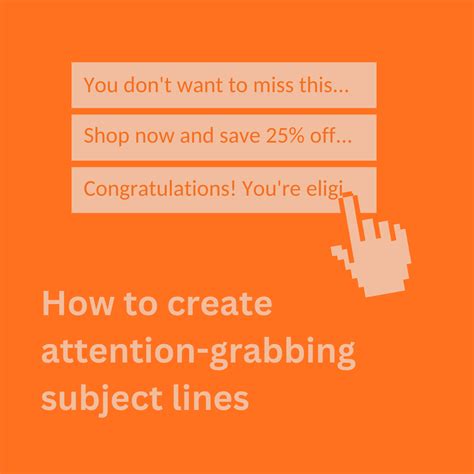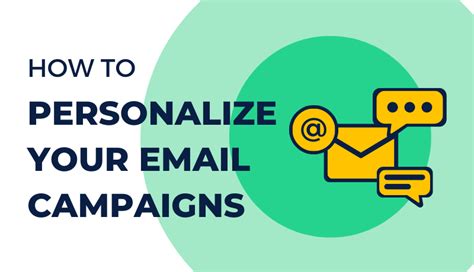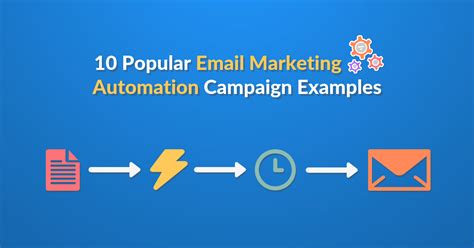Engaging with your audience has never been more crucial in today's dynamic digital landscape. In order to captivate and retain the attention of your target customers, it is imperative that you establish an effective communication channel. One such powerful tool that continues to reign supreme is email marketing. By harnessing the potential of email campaigns, you can ensure that your message reaches the right people at the right time. Unleash the power of your brand's voice and create lasting impressions with these essential techniques.
1. Craft Compelling Subject Lines: The first battleground in email marketing is the recipient's inbox. A well-crafted subject line can be the difference between your email being opened or instantly deleted. Make it intriguing, concise, and compelling, enticing your readers to click and explore further. Avoid clichés and clickbait, instead opt for authenticity and curiosity-driven approaches to entice your audience.
2. Personalization is Key: Gone are the days of generic mass emails. In order to truly connect with your subscribers, it is crucial to treat them as individuals. Utilize personalization techniques to dynamically address your recipients by their name and tailor your content to their preferences. By making your subscribers feel valued and understood, you can greatly enhance their engagement with your brand.
3. Focus on Mobile Optimization: In today's mobile-dominated world, it is pivotal that your email campaigns are optimized for seamless viewing on mobile devices. With a majority of people accessing their emails on smartphones and tablets, ensure that your emails feature responsive designs, concise content, and visually appealing visuals. This ensures a smooth user experience, increasing the likelihood of conversion.
4. Nurture Relationships with Drip Campaigns: Building lasting relationships with your subscribers is a key objective in email marketing. Implement drip campaigns - a series of pre-scheduled emails delivered at specified intervals - to nurture prospects and guide them through the customer journey. By offering valuable content, timely promotions, and personalized recommendations, you can foster trust, loyalty, and higher conversion rates.
5. Analyze and Optimize: The power of data cannot be underestimated. Regularly analyze your email campaign metrics to gain insights into your subscribers' preferences, open rates, click-through rates, and conversions. Utilize this data to identify areas of improvement and optimize your campaigns accordingly. A data-driven approach ensures that your efforts are strategic and results-oriented.
By incorporating these invaluable strategies into your email marketing campaigns, you'll be well on your way to strengthening customer relationships, boosting brand awareness, and driving conversions. Remember, in a crowded digital landscape, an effective email campaign can be your golden ticket to success.
Crafting Attention-Grabbing Subject Lines

When it comes to email marketing, one of the most crucial elements that can determine the success of your campaign is your subject line. The subject line serves as a gateway to your email content, offering a sneak peek into what recipients can expect to find inside.
To capture your audience's attention and entice them to open your email, it is essential to craft compelling subject lines that stand out in crowded inboxes. Here are some tips to help you create subject lines that compel your recipients to click:
- Keep it concise: Opt for brevity when writing subject lines, as shorter lines tend to have higher open rates. Aim for around 30-50 characters to ensure your subject line appears fully on both desktop and mobile devices.
- Intrigue with curiosity: Spark curiosity in your audience by using a subject line that teases or asks a thought-provoking question. This can generate interest and compel recipients to open your email to find out more.
- Evoke emotion: Tap into the power of emotions by using subject lines that stir up feelings such as excitement, curiosity, or urgency. Emotionally charged subject lines can create a sense of connection and motivate recipients to take action.
- Personalize your subject lines: Addressing recipients by their name or using personalization tokens can make your emails feel more personalized and tailored to individual recipients. This personalized touch can increase open rates and engagement.
- Create a sense of exclusivity: Use subject lines that convey exclusivity or limited-time offers to create a sense of urgency. People are more likely to open emails that make them feel they have access to exclusive information or deals.
By implementing these strategies, you can significantly improve the effectiveness of your email marketing campaigns and increase open rates. Remember, a well-crafted subject line is the key to capturing your audience's attention and enticing them to engage with your content.
Creating a Focused Mailing List
Developing a targeted email database is a key component of successful email marketing campaigns. By carefully curating a list of contacts who have expressed genuine interest or have a high likelihood of engaging with your content, businesses can maximize the effectiveness and reach of their email campaigns. In this section, we will explore the essential strategies for building a targeted email list.
| 1. Define Your Ideal Audience |
| Before embarking on the process of building an email list, it is crucial to identify and understand your target audience. Determine who your products or services cater to and create buyer personas that represent your ideal customers. This will enable you to craft more personalized and relevant emails, increasing the chances of engagement and conversion. |
| 2. Optimize Your Website for Lead Generation |
| Make your website a powerful tool for capturing potential leads. Incorporate eye-catching and strategically placed call-to-action buttons, enticing visitors to subscribe to your email list. Offer valuable incentives such as exclusive content, discounts, or free resources in exchange for their email addresses. |
| 3. Leverage Social Media Channels |
| Expand your reach by leveraging the power of social media platforms. Create compelling and shareable content that encourages users to engage with your brand and opt-in to your mailing list. Promote your email newsletters and offers through targeted ads, sponsored posts, and relevant community groups. |
| 4. Run Effective Email Campaigns |
| Deliver valuable content to your existing subscribers, encouraging them to refer others to join your mailing list. Implement effective email marketing strategies, including personalized subject lines, engaging email templates, and clear calls-to-action. By consistently providing value to your subscribers, you increase the likelihood of them forwarding your emails to their network. |
| 5. Regularly Clean and Segment Your Email List |
| Maintain a clean and organized email list by regularly removing inactive or unengaged subscribers. Segment your list based on various criteria such as demographics, purchase history, or engagement levels. This allows for more targeted messaging, enhancing the relevance and effectiveness of your email campaigns. |
Personalizing Your Emails to Make a Lasting Impression

When it comes to email marketing, one of the most effective strategies is to personalize your emails for maximum impact. By customizing your email content to suit the preferences, needs, and interests of your audience, you can create a more meaningful and engaging experience that resonates with each recipient on a personal level.
Personalization goes beyond simply addressing the recipient by their name. It involves tailoring the content, tone, and messaging of your emails to match the individual preferences and characteristics of your target audience. By doing so, you can grab their attention, build trust, and ultimately drive conversions.
One way to personalize your emails is by segmenting your email list based on specific criteria, such as demographics, previous purchasing behavior, or engagement with your brand. This allows you to send targeted emails that are relevant and valuable to each segment, increasing the chances of your recipients engaging with your content and taking the desired action.
In addition to segmenting your email list, you can further personalize your emails by using dynamic content. Dynamic content allows you to dynamically change certain elements of your email based on the recipient's preferences or behavior. For example, you can showcase different products or offers based on their previous browsing or purchasing history, providing a personalized and tailored experience.
Another effective method of personalization is to use personalized subject lines and preheader text. These are the first things your recipients see when they receive your email, so it's crucial to make them attention-grabbing and relevant. By incorporating personalization tokens or dynamic content into your subject lines and preheader text, you can create a sense of urgency, curiosity, or exclusivity that entices your recipients to open and engage with your emails.
Lastly, don't underestimate the power of personalization in the email body itself. Address your recipients by name, showcase products or recommendations based on their interests or browsing history, and use a conversational tone that makes them feel like you're speaking directly to them. This level of personalization helps to establish a connection and foster a sense of trust and loyalty with your audience.
In conclusion, personalizing your emails for maximum impact is crucial in today's competitive email marketing landscape. By segmenting your email list, using dynamic content, incorporating personalized subject lines and preheader text, and tailoring the email body to suit your audience, you can create a more personalized and engaging email experience that drives results and helps you stand out from the crowd.
Optimizing Email Content for Mobile Devices
Email content that is designed for optimal performance on mobile devices is a critical element in the success of your email marketing campaigns. As more and more people access their emails on smartphones and tablets, it is crucial to ensure that your email content is responsive, visually appealing, and easy to navigate on smaller screens.
When crafting your email content for mobile devices, consider the following tips:
1. Simplify your layout: Keep the design clean and uncomplicated, with a single column format that is easy to read and navigate. Avoid the use of excessive images or complex tables that may not display properly on mobile devices. Prioritize the most important information and make it easily scannable.
2. Use short, concise subject lines: Mobile users tend to scan their inbox quickly, so make sure your email subject lines are attention-grabbing and to the point. Keep them within 3-5 words if possible, ensuring they are impactful even on smaller screens.
3. Optimize images and reduce file sizes: Compress and resize your images to ensure quick loading times and reduced email size. Large images may take longer to load on mobile devices, leading to a poor user experience and increased chances of your email being deleted before it is even read.
4. Make your call-to-action buttons easily clickable: Ensure that any buttons or links you include in your email are large enough to be easily tapped with a finger. Use contrasting colors and provide enough space around the buttons to avoid accidental clicks on neighboring links.
5. Test across different devices and email clients: Don't assume that your email looks great on one mobile device and email client will automatically look the same on all others. Test your emails across various devices, screen sizes, and email clients to ensure a consistent and optimized experience for all recipients.
By optimizing your email content for mobile devices, you enhance the chances of engaging your audience and achieving your desired results. Be mindful of the unique challenges and opportunities presented by mobile devices, and always strive to provide a seamless and user-friendly experience for your subscribers.
Achieving Efficiency through Automated Email Campaigns

In the realm of email marketing, there is a powerful tool that can significantly enhance efficiency and effectiveness: automated email campaigns. By incorporating automation into your marketing strategy, you can streamline your processes, save time, and optimize your results.
One of the key advantages of automating your email campaigns is the ability to personalize content and target specific segments of your audience. This is accomplished through the use of segmentation, where contacts are categorized based on their behavior, preferences, or demographics. By tailoring your messages to the unique needs and interests of each segment, you can deliver more relevant and engaging content, leading to higher open rates and conversions.
Another benefit of automation is the ability to create and schedule email sequences in advance. Instead of manually sending each email, you can set up a series of messages to be automatically delivered at predetermined intervals. This allows you to maintain a consistent and strategic communication flow with your subscribers, nurturing them through the buyer's journey without constant manual intervention.
- Workflow automation: Streamline your email marketing processes by automating workflows. By defining triggers, actions, and conditions, you can create a logical sequence of events that guides your subscribers towards desired actions.
- Drip campaigns: Engage your audience over a period of time by setting up drip campaigns. These automated email sequences are designed to gradually deliver information, build relationships, and drive conversions.
- Behavioral triggers: Leverage the power of automation by triggering emails based on specific actions or behaviors exhibited by your contacts. Whether it's a welcome message, abandoned cart reminder, or post-purchase follow-up, behavioral triggers help you deliver timely and relevant content.
- Personalization: Utilize data and segmentation to personalize your email content. By addressing subscribers by their name, recommending products based on their past purchases, or tailoring offers to their preferences, you can create a personalized experience that resonates with your audience.
- Analytics and tracking: Measure the success of your automated email campaigns through comprehensive analytics and tracking. Gain insights into open rates, click-through rates, conversion rates, and more to refine your strategies and optimize your results.
In conclusion, automating your email campaigns is a crucial step towards achieving efficiency in your marketing efforts. By embracing the power of automation, you can deliver personalized content, streamline your processes, nurture your audience, and ultimately drive better results for your business.
FAQ
What are some important tips for effective email marketing?
Some important tips for effective email marketing include building an engaged and targeted email list, personalizing your emails, creating compelling subject lines, having a clear call to action, and testing and analyzing your results for continuous improvement.
How can I build an engaged and targeted email list?
You can build an engaged and targeted email list by offering valuable content or incentives in exchange for sign-ups, utilizing opt-in forms on your website or landing pages, segmenting your list based on specific demographics or interests, and regularly engaging with your subscribers through quality email content.
Why is personalization important in email marketing?
Personalization is important in email marketing because it allows you to create a more personalized and relevant experience for your subscribers. By addressing them by their name, sending tailored content based on their preferences, or incorporating past purchase history, you can increase engagement, open rates, and conversion rates.
What makes a compelling subject line?
A compelling subject line is one that grabs the attention of the reader and entices them to open the email. It should be concise, intriguing, and relevant to the content of the email. Including personalization, urgency, or curiosity can also make a subject line more compelling.
How can I test and analyze the effectiveness of my email marketing campaigns?
You can test and analyze the effectiveness of your email marketing campaigns by utilizing A/B testing to compare different elements of your emails, such as subject lines or call-to-action buttons, tracking open rates, click-through rates, conversion rates, and analyzing the data from email marketing software or analytics tools. This data will provide insights into what strategies are working and where improvements can be made.



